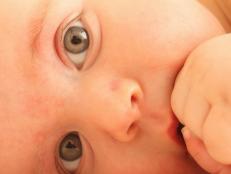Could My Children's Toys Contain Lead? How to Find Out!
An expert weighs in on preventing your child's exposure to lead.

iStock
Flint, Michigan, has been in the headlines over the past five months because dangerously high levels of lead were found in the city's water supply. According to reports, between 6,000 to 12,000 children in the area were exposed to lead, and the rest of the country has been watching, horrified.
Even small amounts of exposure to this metal can cause serious health issues, and children are especially at risk. Lead poisoning in children can lead to developmental delays, learning difficulties, and plenty of other averse effects. And though you can get exposed to lead through water (usually due to lead in the pipes it passes through), lead can also be found in paint, furniture, and toys.
Though lead-based paints and plastics were banned in 1978, it's still a hazard that affects 25 percent of U.S. homes. If your house was built before this, there's a good chance you may be exposed to lead, and you can take precautions to prevent it. But with toys, it's much harder to determine if you're at risk.
Thankfully, there's a little something called the Consumer Products Safety Improvement Act (CPSIA), which imposed new testing and documentation requirements and regulated acceptable levels of potentially hazardous substances, like lead.
What do I need to look for?
"The CPSIA reduced lead content in toys in 2008 to 600 parts per million," explains Dr. Aly Cohen, an autoimmune disease specialist and founder of The Smart Human. "By 2012, the amount of lead allowed in most new products for children 12 and younger was 100 parts per million."
Cohen uses The Smart Human to give tips on how to reduce exposure to everyday chemicals and radiation. When it comes to toys, she recommends only buying toys that are:
1. Manufactured after 2012
2. Made in the United States
3. Sold by a reputable company
"Toys really become an issue when it comes to choosing toys from other countries that have much more limited oversight," she says. She also recommends you skip the dollar store, because they "don't have very good oversight from a manufacturing standpoint."
Be wary of costume jewelry and hand-me-down items
And toys aren't the only thing to worry about. Dr. Cohen points out that costume jewelry, like Mardi Gras beads, can contain lead, chromium and mercury. "Costume jewelry does not fall under toys," she says, and therefore isn't always held to the same standards. Plus kids seem to love putting anything shiny in their mouths, right? If you don't know where costume jewelry came from, keep it out of kids' reach.
When it comes to toys that are being handed down between generations or gifted from neighbors, you want to check where they toy was manufactured in order to make sure it is safe. The CPSC has a list of recalled items that may be useful, and though there are DIY kits, a certified laboratory is the only way to accurately test toys.
When it doubt, though, leave a questionable toy on the shelves, or, better yet, in the garbage.















